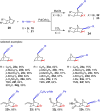Metal-Catalyzed Haloalkynylation Reactions
- PMID: 34644433
- PMCID: PMC9299716
- DOI: 10.1002/chem.202103046
Metal-Catalyzed Haloalkynylation Reactions
Abstract
Metal catalysis has revolutionized synthetic chemistry, leading to entirely new, very efficient transformations, which enable access to complex functionalized molecules. One such new transformation method is the haloalkynylation reaction, in which both a halogen atom and an alkynyl unit are transferred to an unsaturated carbon-carbon bond. This minireview summarizes the development of metal-catalyzed haloalkynylation reactions since their beginning about a decade ago. So far, arynes, alkenes and alkynes have been used as unsaturated systems and the reactivities of these systems are summarized in individual chapters of the minireview. Especially, the last few years have witnessed a rapid development due to gold-catalyzed reactions. Here, we discuss how the choice of the catalytic system influences the regio- and stereoselectivity of the addition.
Keywords: C−C coupling; catalysis; haloalkynes; haloalkynylation.
© 2021 The Authors. Chemistry - A European Journal published by Wiley-VCH GmbH.
Conflict of interest statement
There is no conflict of interest to declare.
Figures



























Similar articles
-
Indium(III)-Catalyzed Haloalkynylation Reaction of Alkynes.Chemistry. 2024 Jul 2;30(37):e202401070. doi: 10.1002/chem.202401070. Epub 2024 May 14. Chemistry. 2024. PMID: 38742960
-
Gold(I)-Catalyzed Haloalkynylation of Aryl Alkynes: Two Pathways, One Goal.Angew Chem Int Ed Engl. 2020 Jun 8;59(24):9433-9437. doi: 10.1002/anie.201916027. Epub 2020 Apr 6. Angew Chem Int Ed Engl. 2020. PMID: 32078231 Free PMC article.
-
Iron- and Cobalt-Catalyzed Asymmetric Hydrofunctionalization of Alkenes and Alkynes.Acc Chem Res. 2021 Jun 1;54(11):2701-2716. doi: 10.1021/acs.accounts.1c00212. Epub 2021 May 19. Acc Chem Res. 2021. PMID: 34011145
-
Transition metal-carboryne complexes: synthesis, bonding, and reactivity.Acc Chem Res. 2011 Apr 19;44(4):299-309. doi: 10.1021/ar100156f. Epub 2011 Mar 11. Acc Chem Res. 2011. PMID: 21395260 Review.
-
Metal Catalysis in Thiolation and Selenation Reactions of Alkynes Leading to Chalcogen-Substituted Alkenes and Dienes.ChemistryOpen. 2015 Sep 9;4(6):682-97. doi: 10.1002/open.201500137. eCollection 2015 Dec. ChemistryOpen. 2015. PMID: 27308193 Free PMC article. Review.
Cited by
-
Photoinduced inverse Sonogashira coupling reaction.Chem Sci. 2022 May 30;13(25):7475-7481. doi: 10.1039/d2sc01933g. eCollection 2022 Jun 29. Chem Sci. 2022. PMID: 35872819 Free PMC article.
References
-
- Morishita T., Yoshida H., Ohshita J., Chem. Commun. 2010, 46, 640–642. - PubMed
-
- Brand J. P., Waser J., Chem. Soc. Rev. 2012, 41, 4165–4179. - PubMed
-
- Wu W., Jiang H., Acc. Chem. Res. 2014, 47, 2483–2504. - PubMed
-
- H. Jiang, C. Zhu, W. Wu, in Haloalkyne Chemistry, Springer, Heidelberg, 2016.
-
- Petrone D. A., Ye J., Lautens M., Chem. Rev. 2016, 116, 8003–8104. - PubMed
Publication types
Grants and funding
LinkOut - more resources
Full Text Sources

